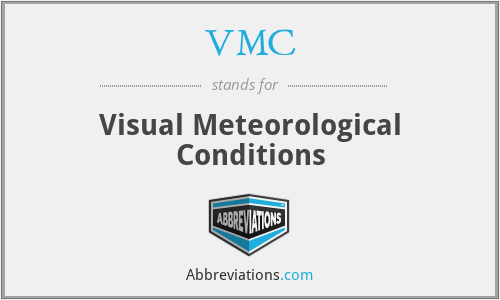What does VMC mean in Transportation?
This page is about the meanings of the acronym/abbreviation/shorthand VMC in the Governmental field in general and in the Transportation terminology in particular.
Translation
Find a translation for Visual Meteorological Conditions in other languages:
Select another language:
- - Select -
- 简体中文 (Chinese - Simplified)
- 繁體中文 (Chinese - Traditional)
- Español (Spanish)
- Esperanto (Esperanto)
- 日本語 (Japanese)
- Português (Portuguese)
- Deutsch (German)
- العربية (Arabic)
- Français (French)
- Русский (Russian)
- ಕನ್ನಡ (Kannada)
- 한국어 (Korean)
- עברית (Hebrew)
- Gaeilge (Irish)
- Українська (Ukrainian)
- اردو (Urdu)
- Magyar (Hungarian)
- मानक हिन्दी (Hindi)
- Indonesia (Indonesian)
- Italiano (Italian)
- தமிழ் (Tamil)
- Türkçe (Turkish)
- తెలుగు (Telugu)
- ภาษาไทย (Thai)
- Tiếng Việt (Vietnamese)
- Čeština (Czech)
- Polski (Polish)
- Bahasa Indonesia (Indonesian)
- Românește (Romanian)
- Nederlands (Dutch)
- Ελληνικά (Greek)
- Latinum (Latin)
- Svenska (Swedish)
- Dansk (Danish)
- Suomi (Finnish)
- فارسی (Persian)
- ייִדיש (Yiddish)
- հայերեն (Armenian)
- Norsk (Norwegian)
- English (English)
Definition
What does VMC mean?
- Visual meteorological conditions
- In aviation, visual meteorological conditions (VMC) is an aviation flight category in which visual flight rules (VFR) flight is permitted—that is, conditions in which pilots have sufficient visibility to fly the aircraft maintaining visual separation from terrain and other aircraft. They are the opposite of instrument meteorological conditions (IMC). The boundary criteria between IMC and VMC are known as the VMC minima and are defined by: visibility, cloud ceilings (for takeoffs and landings), and cloud clearances. The exact requirements vary by type of airspace, whether it is day or night (for countries that permit night VFR), and from country to country. Typical visibility requirements vary from one statute mile to five statute miles (many countries define these in metric units as 1,500 m to 8 km). Typical cloud clearance requirements vary from merely remaining clear of clouds to remaining at least one mile away (1,500 m in some countries) from clouds horizontally and 1,000 feet away from clouds vertically. For instance, in Australia, VMC minima outside controlled airspace are clear of cloud with 5,000 m visibility below 3,000 ft AMSL or 1,000 ft AGL (whichever is higher), and 1,000 ft vertical/1,500 m horizontal separation from cloud above these altitudes or in controlled airspace. Above 10,000 ft, 8,000 m visibility is required to maintain VMC. Air traffic control may also issue a "special VFR" clearance to VFR aircraft, to allow departure from a control zone in less than VMC – this reduces the visibility minimum to 1,600 m. Generally, VMC requires greater visibility and cloud clearance in controlled airspace than in uncontrolled airspace. In uncontrolled airspace there is less risk of a VFR aircraft colliding with an instrument flight rules (IFR) aircraft emerging from a cloud, so aircraft are permitted to fly closer to clouds. An exception to this rule is class B airspace, in which ATC separates VFR traffic from all other traffic (VFR or IFR), which is why in class B airspace lower cloud clearance is permitted.
Popularity rank by frequency of use
How popular is VMC among other acronyms?
VMC#1#5096#12977
Embed
Citation
Use the citation below to add this abbreviation to your bibliography:
Style:MLAChicagoAPA
"VMC." Abbreviations.com. STANDS4 LLC, 2024. Web. 10 Nov. 2024. <https://www.abbreviations.com/term/48894>.



Discuss this VMC abbreviation with the community:
Report Comment
We're doing our best to make sure our content is useful, accurate and safe.
If by any chance you spot an inappropriate comment while navigating through our website please use this form to let us know, and we'll take care of it shortly.
Attachment
You need to be logged in to favorite.
Log In